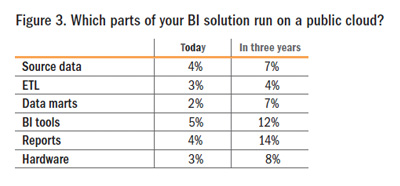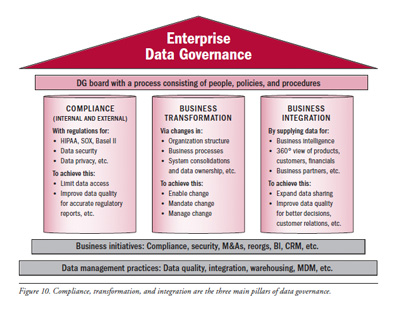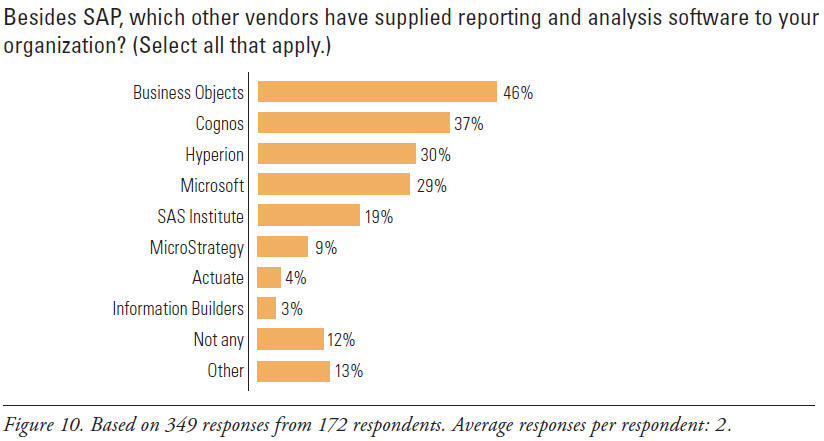





January 14, 2010
ANNOUNCEMENTS
New TDWI Best Practices Report: Transforming Finance
Download the latest TDWI Best Practices Report here.
CONTENTS

In Store for ’10: Jill’s New Year’s Prognostications

The Three Pillars of Data Governance

Reporting and Analysis Tools from SAP and Third-Party Vendors

Mistake: No Emergency or Appeal Process

See what's
current in TDWI Education, Research, Webinars, and Marketplace

In Store for ’10: Jill’s New
Year’s Prognostications
Jill Dyche
Baseline Consulting
How was your 2009? Yeah, mine too. My mind was on healthcare reform, credit-default swaps, the polar ice cap, and Tiger Woods. If we’re not obsessed with the latest IT trends at the moment, who can blame us?
As obligations loom and prospects variously dim and brighten, I have noted some interesting developments in 2009 that will gain traction in the coming year. Herewith, my prognostications for 2010:
1. Management starts adopting the phrase “data as an asset.” Yay, right? Wrong! It’s often the same executives who are unwilling to fund data improvements. They don’t know what data as an asset really means, so they’re hardly ready to invest in data proportional to their other corporate assets. If this sounds familiar, use it as an opportunity to do some missionary work quickly--before your executives lose interest and are on to the next buzzword.
2. IT executives get deliberate about the cloud. The cloud has become a euphemism for everything from off-premise grid computing to Web-based data access to virtualization on steroids. Cloud computing helps companies quickly deploy functionality, often in a fraction of the time it would have taken to procure specialized software, hire and train internal staff, gear up installation planning, and deploy the necessary functionality. However, executives are still reluctant to put mission-critical systems in the cloud, despite vendor progress in obtaining rigorous security certifications. Watch for more questions and longer acquisition cycles. (See Figure 3, pulled from the TDWI World Conference Trip Report, Orlando 2009.)
3. “Global” versus “local” data governance. As business managers take steps to formalize the policy making and oversight of enterprise information, the assumption has been that data governance will naturally encompass all enterprise data. Not so fast. There is global data--the shared, enterprisewide, heterogeneous kind shared by a range of organizations and departments. However, there is also “local” data that might belong only to a specific country, region, or business unit. I liken this to the McDonald’s menu. You can get a Quarter Pounder almost anywhere, but in Boston in the summer, you can find the McLobster Sandwich. Know where your lobster sandwiches are, because the cooks are different and the recipe is often secret!
4. Management scrutinizes tool adoption and usage. Forty-eight percent of respondents to a December 2009 Kognitio survey reported that they will be adding new BI functionality via existing environments in 2010. As we’re fond of saying, “Shake what your momma gave you!” Folks are still touchy about capital budgets--be sure to track ongoing usage and value.
5. Customers clamor for social media capabilities, yet your executives remain resistant. Why? They don’t perceive the value. Many CIOs still cling to old ways of doing business, despite pressures to satisfy the increasing appetite of Web 2.0–savvy customers wanting to engage online. Facebook fan page? Why? Marketing’s still doing campaigns! Customer service on Twitter? Our reps aren’t trained. Low-cost recruiting on LinkedIn? Pshaw! Lesson: take social media as seriously as your customers do.
6. Management still doesn’t care about metadata. This doesn’t mean you should ignore metadata--just avoid making it an intellectual exercise. Take pointers from Jerry Seinfeld’s wife Jessica, who spins broccoli in the blender, then pours it into her brownie mix. They won’t even know metadata’s been delivered, but it will be good for them.
7. Mobile dashboards light up. The mobile workforce is gaining on us, and so are mobile voice and data services. A retailer we work with has recently armed its sales staff with mobile dashboards. When a shopper has a question, a sales associate can enter the loyalty number and have credit, payment history, and recent purchases literally in the palm of her hand. Field service workers, store associates, sales agents, and regional account reps can get out from behind their desks, leave their laptops in their briefcases, and actually focus on the customer interaction.
8. Recruiting becomes a priority (again). Okay, say it with me: “Our company is only as good as its people.” There. However, as decision making is pushed down to lower levels of the organization (see prognostications 3, 4, 5, and 7), recruiting processes and metrics become even more critical.
9. Systems are decommissioned. The scary truth is that the investment wave of the early 2000s is reaching its natural ebb. Many of these solutions are becoming too expensive, obsolete, or both. IT will be looking for new, low-cost alternatives to replace them. That doesn’t mean they’ll spend all their money in 2010, but they will get serious about technologies such as database appliances, functionality in the cloud, and open source tools as viable alternatives.
10. Better business/IT alignment. It won’t happen in 2010, or even in 2011, but it will come up, and executives will start weighing in on tactics to fix what’s not working.
May you have more fun, try new things, and succeed beyond your wildest dreams in 2010.
Jill Dyche is a partner and co-founder of Baseline Consulting. She is the author of three acclaimed books and co-chair of TDWI’s Master Data, Quality, and Governance Solution Summit. Jill’s blog, Inside the Biz, focuses on the business value of IT.

The Three Pillars of Data Governance
Philip Russom
TDWI Research
Data governance (DG) intersects with many different business initiatives and IT implementations. The intersection, of course, results from a focus on data that DG shares with data-driven business initiatives such as compliance, BI, CRM, business transformations, global spend analysis, accurate reporting and forecasting, and so on. Likewise, policies and procedures established by a DG program influence almost all data management implementations, including those for data quality, data integration, data warehousing, database administration, enterprise data architecture, and MDM.
The many business initiatives and data management implementations mentioned above constitute a daunting list that’s tough to remember. Let’s give the list some structure and make it more memorable by boiling it down to the three pillars of an enterprisewide program, namely: compliance, transformation, and integration. (See Figure 10.)
These three pillars are a generalization that represents the most common goals for data governance programs. Each can be a starting point for a new DG program, and all three relate and share dependencies in a mature, enterprisewide program. Let’s drill into the three pillars.
Compliance
At one end of the spectrum, many organizations initiate data governance programs because of pressing compliance issues that impact data usage. These issues are diverse, involving internal policies (for data security and privacy), legislated regulations (Basel II, HIPAA, and SOX), and standards for data exchange (EDI, HL7, SWIFT, etc.). An organization may begin with a subset of data-related compliance--typically HIPAA and other data privacy regulations--and then expand to SOX compliance, regulatory reports, and data security. Note that achieving compliance relative to data often involves limiting the number of people and applications with access to certain data as well as how they may use the data.
A data governance board assists by interpreting what each of these compliance issues means to the organization. The interpretation should be expressed as policies and procedures for data usage that must be followed by specific members of the organization. When compliance requires regulatory reports, governing the quality of report data takes priority. Sometimes DG mandates that an audit trail for report data be kept in case the organization is audited. You can see that compliance, data governance, and data quality are strongly related, which is why all three are part of a single program in many organizations.
Business Integration
At the other end of the spectrum, some organizations begin by governing data that is shared broadly through a variety of data integration and application integration technologies. Technology aside, the point is to achieve business integration through data integration. Although shared data is subject to compliance, the focus here is on expanding data access and integration. The goal of business integration is to enable data-driven business activities such as BI, CRM, and cross-business data exchange (whether between business units of the same firm or partners in a supply chain). Sharing data broadly enables faster and better decisions and improves customer relations, supply chain operations, and so on.
The data governance board can help expand data integration by providing procedures through which one organization can request access to another’s data. Because downstream data practices such as data warehousing and customer data integration suffer from the poor quality of upstream data, DG procedures should enable these teams to request improvements in upstream data sources such as operational applications. A DG board can establish data exchange standards. Some firms go as far as establishing a DG-controlled integration competency center, which provides an infrastructure for data integration.
Business Transformation
In the middle, transformation is a goal unto itself as well as an enabler for the goals of compliance and integration. The meaning and degree of transformation varies, but it always involves some kind of change. For instance, to comply with the data security requirements of SOX, most U.S. corporations have changed who can access which data. Other firms have changed the ownership of data as they move toward using “data as an enterprise asset.” Most improvements in data quality require that operational application owners and users change their systems and how they’re used. We’ve all seen numerous business transformations--especially reorganizations and mergers and acquisitions--that force dramatic changes in data ownership and usage.
Regardless of the degree of change seen in these examples, all benefit from data governance as a change management mechanism. Users whom TDWI Research interviewed for this report regularly pointed out that their data management and business process changes would not have happened without a data governance board to approve the changes and enforce them across all business units. Several interviewees created a DG board before attempting business or technical initiatives that require considerable changes to data ownership, quality, and usage.
Again, DG-controlled business transformation is a goal unto itself (especially with reorganizations and mergers), as well as an enabler (in the form of change management) for the data governance goals of compliance and integration. That’s why, in Figure 10, enterprise data governance both arches over the three pillars and reaches into the middle one. Furthermore, the figure positions transformation in the middle because a DG board can serve as a broker between compliance’s need to limit data access and integration’s need to expand it. In other words, DG can help expand data sharing without compromising data compliance goals.
Philip Russom is the senior manager of research and services at TDWI, where he oversees many of TDWI’s research-oriented publications, services, and events.


Highlight of key findings from TDWI's wide variety of research
Reporting and Analysis Tools from SAP and Third-Party Vendors
Most industry analyst firms knowledgeable in BI (like IDC and Forrester Research) list Business Objects, Cognos, and Hyperion as the top three reporting and analysis vendors in terms of annual revenue or market share. So, it’s no surprise to see these vendors at the top of the survey results in Figure 10, which charts third-party BI providers for SAP. Hence, the SAP user community is using reporting and analysis tools in proportions nearly identical to the broader BI community.
However, the fact that SAP users have acquired third-party tools at all is interesting. Don’t forget: the survey respondents for Figure 10 are all SAP users. The average number of responses per respondent is two, so an SAP customer on average uses two reporting or analysis products from other vendors. The point is that SAP users are somewhat voracious in tool consumption: they generously use BI products from SAP, as well as products from many other vendors.
Source: Business Intelligence Solutions for SAP (TDWI Best Practices Report, Q4 2007). Click here to access the report.


FlashPoint Rx prescribes a "Mistake to Avoid" for business intelligence and data warehousing professionals.
Mistake:
No Emergency or Appeal Process
By Jonathan G. Geiger, Claudia Imhoff, and Lisa Loftis, Intelligent Solutions, Inc.
For most business requests, the center of excellence will follow its documented procedures and processes. However, situations will arise when the business must have a data set, report, analytic result, or application created unexpectedly. If the COE refuses to consider the request or deal with the emergency, then the business will find another way to solve its problem. Usually this means doing an end-run around the COE and creating a silo or shadow BI application. While it may be a short-term fix to the emergency, this is not good for anyone in the long run.
The COE must have a process in place to accommodate emergency requests. The process should include a recognized approach for evaluating the emergency so that the emergency request is pursued or rejected with the backing of the governance body. To pursue the emergency, the COE may have to shortcut its own processes and procedures to avoid an end-run. A stopgap procedure should be developed that streamlines or goes around the normal procedure, perhaps even leading to a standalone application. The key to success in this situation is to ensure that, if a shortcut is taken, the appropriate long-term solution is pursued once the emergency has been handled. Once that solution is in place, the shortcut should be removed and no longer used.
Source: Ten Mistakes to Avoid When Creating a Center of Excellence (Q4 2006). Click here to access the publication.




